US inflation decelerating in boost to economy

US prices fell in November for the first in more than 3-1/2 years, pushing the annual increase in inflation further below 3 percent, and boosting financial market expectations of an interest rate cut from the Federal Reserve next March.
The report from the Commerce Department on Friday also showed underlying inflation pressures continuing to subside. Cooling inflation left more income at the disposal of households, helping to underpin consumer spending and the overall economy as the year winds down.
This was yet another data set showcasing the durability of the economic expansion, thanks to a resilient labor market. The economy has defied dire predictions of recession from economists and some business executives going back to late 2022.
"(Fed) Chair (Jerome) Powell couldn't have asked for a better present this year," said Sal Guatieri, a senior economist at BMO Capital Markets in Toronto. "So far at least, the endgame is turning out better than the Fed or nearly anyone could have imagined at the start of the year. While the Fed won't rush into cutting rates, it's likely now just a matter of time."
Inflation, as measured by the personal consumption expenditures (PCE) price index, fell 0.1 percent last month, the Commerce Department's Bureau of Economic Analysis said. That was the first monthly decline in the PCE price index since April 2020 and followed an unchanged reading in October.
Food prices edged down 0.1 percent and energy prices dropped 2.7 percent. In the 12 months through November, the PCE price index increased 2.6 percent after rising 2.9 percent in October. October marked the first time since March 2021 that the annual PCE price index was below 3 percent.
Economists polled by Reuters had forecast the PCE price index unchanged on the month and rising 2.8 percent year-on-year.
Excluding the volatile food and energy components, the PCE price index rose 0.1 percent in November, matching October's gain.
The so-called core PCE price index advanced 3.2 percent year-on-year, the smallest rise since April 2021, after increasing 3.4 percent in October. The Fed tracks the PCE price measures for its 2 percent inflation target.
The government reported on Thursday that core PCE inflation increased at a 2.0 percent annualized rate in the third quarter. That, combined with November's mild gain, put the six-month core PCE inflation rate at 1.9 percent.
Monthly inflation readings of 0.2 percent on a sustainable basis are needed to bring inflation back to the Fed's target, economists say. Financial markets saw a roughly 75 percent chance of a rate cut at the Fed's March 19-20 policy meeting, according to CME Group's FedWatch Tool.
Subsiding inflation is brightening the mood for many Americans, with a separate report from the University of Michigan on Friday showing consumer sentiment soaring in December, reversing all declines from the previous four months.
President Joe Biden, whose popularity has been hurt by unhappiness over the high cost of living, welcomed the news.
"This reflects the hard work we did together to fix our supply chains and the surge of Americans into the workforce. It's remarkable progress," Biden said in a statement.
Stocks on Wall Street were trading higher. The dollar fell against basket of currencies. US Treasury prices rose.
CONSUMER SPENDING RISES
The US central bank held rates steady last week and policymakers signaled in new economic projections that the historic monetary policy tightening engineered over the last two years is at an end and lower borrowing costs are coming in 2024. Since March 2022, the Fed has hiked its policy rate by 525 basis points to the current 5.25 percent-5.50 percent range.
With the labor market still fairly tight, wages jumped 0.6 percent last month, more than offsetting the drag on personal income from decreases in government aid, including food stamps, social security and Medicaid. Personal income rose 0.4 percent.
The saving rate ticked up to 4.1 percent from 4.0 percent in the prior month, which bodes well for spending.
Income at the disposal of households after accounting for inflation and taxes rose 0.4 percent after gaining 0.3 percent in October.
That allowed Americans to open their wallets at the start of the holiday shopping season. Consumer spending, which accounts for more than two-thirds of US economic activity, increased 0.2 percent last month after rising 0.1 percent in October.
When adjusted for inflation, overall consumer spending increased 0.3 percent after nudging up 0.1 percent in October. The pick up in the so-called real consumer spending added to data this week, including single-family housing starts and building permits, in suggesting the economy was regaining speed after appearing to falter at the start of the fourth quarter.
That was reinforced by a third report from the Commerce Department's Census Bureau showing orders for durable goods jumped 5.4 percent in November, recouping October's 5.1 percent drop.
Though a fourth report from the Census Bureau showed new home sales plunging 12.2 percent to a seasonally adjusted annual rate of 590,000 units in November, a one-year low, the drop is likely temporary amid a dearth of previously owned houses on the market. Mortgage rates continue to decline from 23-year highs, which should help new home sales.
Gross domestic product growth estimates for the fourth quarter range from as low as a 1.1 percent annualized rate to as high as a 2.8 percent pace. The economy grew at a 4.9 percent rate in the third quarter.
"The US economy is doing well heading into 2024," said Gus Faucher, chief economist at PNC Financial in Pittsburgh, Pennsylvania. "No recession in 2024."

 For all latest news, follow The Daily Star's Google News channel.
For all latest news, follow The Daily Star's Google News channel. 








Comments